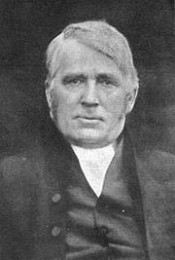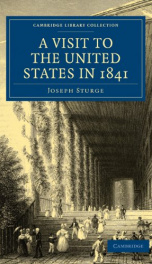Sturge Joseph

Joseph Sturge (1793 - May 14, 1859), son of a farmer in Gloucestershire, was an English Quaker, abolitionist and activist. He founded the British and Foreign Anti-Slavery Society (now Anti-Slavery International). He worked throughout his life in Radical political actions supporting pacifism, working-class rights, and the universal emancipation of slaves. In the late 1830s he published two books about the apprenticeship system in Jamaica, which helped persuade the British Parliament to adopt an earlier full emancipation date. In Jamaica Joseph Sturge also helped found Free Villages with the Baptists, to provide living quarters for freed slaves. One was named "Sturge Town" in his memory. Joseph Sturge went to Birmingham to work in 1822. A member of the Religious Society of Friends (commonly known as Quakers), Joseph Sturge refused to deal in grain used in the manufacture of alcoholic spirits, although he was a corn factor. In rapidly expanding industrial Birmingham, he was appointed an alderman in 1835. He opposed the building of the Birmingham Town Hall, to be used for performances, because of his conscientious objection to the performance of sacred oratorio. Joseph Sturge became interested in the island of Jamaica and the conditions of its enslaved workers. He visited it several times and witnessed first hand the horrors of slavery, as well as the abuses under an apprenticeship system designed to control the labour of all former slaves above the age of six for 12 years. He worked for emancipation and abolition with African-Caribbean and English Baptists. In 1838, after full emancipation was authorized, Sturgehe laid the foundation stone to the "Emancipation School Rooms" in Birmingham. Attending were United Baptist Sunday School and Baptist ministers of the city. In 1839 his work was honored by a marble monument in a Baptist mission chapelFalmouth, Jamaica. It was dedicated to "the Emancipated Sons of Africa". After legislation for the abolition of slavery in the British dominions was enacted in 1833, slave-owning planters in the West Indies lobbied to postpone freedom for adults for twelve years in a form of indenture. Enslaved children under the age of six were emancipated by the new law on 1 August 1834, but older children and adults had to serve a period of bonded labour or "indentured apprenticeship". Sturge led a campaign against this delaying mechanism. His work to speed up adult emancipation was supported by Quaker abolitionists such as William Allen and many others, including Lord Brougham. In a speech to the House of Lords, Brougham acknowledged Sturge's central role at that time in rousing British anti-slavery opinion. In 1834 Sturge sailed to the West Indies to study apprenticeship as defined by the British Emancipation Act of 1833. He intended to open it to criticism as an intermediate stage en route to emancipation. In the West Indies, he traveled throughout the islands and talked directly to apprentices, proprietors (planters), and others directly involved. Upon his return to Great Britain, he published Narrative of Events since the First of August 1834. In it he cited an African-Caribbean witness. He referred to his source as "James Williams" to protect him from reprisals. The original statement was signed by two free African-Caribbeans and six apprentices. As was customary at the time, it was authenticated, by Rev. Dr. Thomas Price of Hackney, London, who wrote the introduction. Following another trip and further study, Sturge published The West Indies in 1837. Both books highlighted the cruelty and injustice of the system of indentured apprenticeship. Whilst in Jamaica, Sturge worked with the Baptist chapels to found Free Villages, to create homes for freed slaves when they achieved full emancipation. They planned the communities to be outside the control of planters. As a result of Sturge's single-minded campaign, in which he publicized details of the brutality of apprenticeship to shame the British Government, a major row broke out amongst abolitionists. The more radical element were pitted against the government. Although both had the same ends in sight, Sturge and the Baptists, with mainly Nonconformist support, led a successful popular movement for immediate and full emancipation. As a consequence, the British Government moved the the date for full emancipation forward to 1 August 1838. They abolished the 12-year intermediary apprenticeship scheme. For many English Nonconformists and African-Caribbean people, 1 August 1838, became recognised as the true date of abolition of slavery or emancipation in the British Empire. In 1837, keen to act independently of the consensus in the Anti-Slavery Society, Sturge founded the Central Negro Emancipation Committee. More significantly, in 1839, one year after abolition in the British dominions (a time when many members of the Anti-Slavery Society considered their work to be completed), Sturge led a small group to found a new Anti-Slavery Society. They named it the British and Foreign Anti-Slavery Society, based on the ambitious objective of achieving emancipation and an end to slavery worldwide. This society continues today as Anti-Slavery International; its work is far from achieved since slavery exists on a large scale in many countries, albeit no longer legally based. In the 19th century, the Society's first major activity was to organize the first international conference, as well as the first devoted to abolition. It was known as the World's Anti-Slavery Conference and took place in June 1840 in London. Another was held in 1843 (Brussels) and 1849 (Paris). The convention was held at the Freemasons Hall on 12 June 1840.[1] It attracted delegates from Europe, North America, and Caribbean countries, as well as the British dominions of Australia and Ireland, though no delegates from Africa attended. It included African-Caribbean delegates from Haiti and Jamaica (then representing Britain), women activists from the United States, and many Nonconformists. Commissioned by the society and its "moral radicals", a great painting of the event was completed. It hangs in the National Portrait Gallery, London to this day. The conference's political significance lay in the fact-finding groups it set up to report about slavery worldwide. It also created studied links between British investment and business and overseas slavery. The conference was historically notable within the Woman's Suffrage Movementdue to delegates' having excluded women's participation just prior to its opening. Activists Lucretia Mott and Elizabeth Cady Stanton were galvanized to organize a United States movement advocating woman's rights. Stanton, on her honeymoon at the time, and Mott, were active in the US anti-slavery movement. The issue of women's participation provoked the split between followers of Garrison of the American Anti-Slavery Society and Lewis Tappan's American and Foreign Anti-Slavery Society. The latter was ideologically congruent with Sturge's English counterpart. In 1841 Sturge travelled in the United States with the poet Whittier to examine the slavery question there. He published his findings to promote American abolition. On his return to England, Sturge supported the Chartist movement. In 1842 he ran as parliamentary candidate for Nottingham, but was defeated by John Walter, the proprietor of The Times. He then took up the cause of peace and arbitration being pioneered by Henry Richard. He helped found the Peace Society. In addition, he was instrumental in the founding of the Morning Star in 1855 as a newspaper through which to promote the Peace Society and his other socially progressive ideas. Sturge married, first, in 1834, Eliza, daughter of James Cropper. After her death, in 1846 he married Hannah, daughter of Barnard Dickinson. Sturge died at Edgbaston, Birmingham. A memorial to him was unveiled three years later in front of a crowd of 12,000 on 4 June 1862 at Five Ways. It stood at the boundary between Birmingham and Edgbaston. The sculptor was John Thomas, who Sir Charles Barry had employed as stone and wood carver on the former King Edward’s Grammar School at Five Ways. Thomas had also worked on the Palace of Westminster and Balmoral, as well as the reliefs on Windsor and Euston Stations. Sturge is shown in a pose as if he were teaching, with his right hand resting on the Holy Bible to indicate his strong Christian faith. Lower on the plinth, he is flanked by two female allegorical figures. One represents Peace holding a dove and an olive branch, with a lamb at her feet, symbolic of innocence; and the other, Charity, is comforting and giving succour to two Afro-Caribbean infants, and recalling the fight and victory against slavery]. Around the crown of the plinth are inscribed the words "Charity, Temperance and Peace", as well as Sturge's name and the date of his death. In 1925 a plaque was installed at the memorial to tell passers-by more about its subject. The inscription reads: In 2006/7 the partnership of the Birmingham Civic Society, Birmingham City Council and the Sturge family restored the statue for the 200th anniversary of the Slave Trade Act of 1807. The statue is grade II listed. On 24 March 2007, the city held a civic ceremony to formally rededicate the statue. The Lord Mayor of Birmingham unveiled an interpretation board giving details of Sturge's life. On the same day, a blue plaque (historic marker) was unveiled at the site of his home in Wheeleys Road, Edgbaston.[2] This article incorporates text from the Encyclopædia Britannica, Eleventh Edition, a publication now in the public domain.
do you like this author?
What readers are saying
What do you think? Write your own comment on this book!
write a commentWhat readers are saying
What do you think? Write your own comment on this author!
write a commentBook list

A Visit to the United States in 1841
Series:
Unknown
Year:
Unknown
Raiting:
4/5
Joseph Sturge (1793-1859) was an English Quaker who was influential in campaigning for the abolition of slavery in the British empire and founded the British and Foreign Anti-Slavery Society in 1839. Having visited the West Indies in 1834, he travelled to the United States in 1841 to examine the slavery question there firsthand, and to lend his support to the American abolition movement by sharing his experiences of how success was achieved elsewhere. His account of his visit, and of the feelings and opinions of the American campaigners he met, is the subject of this 1842 book, which he hoped would encourage activists around the world and promote understanding among them.
Show more
add to favoritesadd In favorites
Book list

A Visit to the United States in 1841
Series:
Unknown
Year:
Unknown
Raiting:
4/5
Joseph Sturge (1793-1859) was an English Quaker who was influential in campaigning for the abolition of slavery in the British empire and founded the British and Foreign Anti-Slavery Society in 1839. Having visited the West Indies in 1834, he travelled to the United States in 1841 to examine the slavery question there firsthand, and to lend his support to the American abolition movement by sharing his experiences of how success was achieved elsewhere. His account of his visit, and of the feelings and opinions of the American campaigners he met, is the subject of this 1842 book, which he hoped would encourage activists around the world and promote understanding among them.
Show more
add to favoritesadd In favorites
What readers are saying
What do you think? Write your own comment on this author!
write a commentif you like Sturge Joseph try:
readers also enjoyed
What readers are saying
What do you think? Write your own comment on this author!
write a commentif you like Sturge Joseph try:
readers also enjoyed
Do you want to exchange books? It’s EASY!
Get registered and find other users who want to give their favourite books to good hands!

